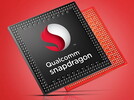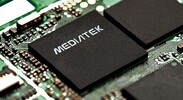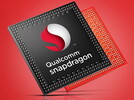Qualcomm Snapdragon 616 MSM8939v2 vs Mediatek MT6750N vs Qualcomm Snapdragon 615 MSM8939
Qualcomm Snapdragon 616 MSM8939v2
► remove from comparison
The Qualcomm Snapdragon 616 MSM8939v2 is a mid-range ARMv8-based SoC largely for Android tablets and smartphones. Announced in February 2014, the S616 is one of the first 64-bit capable SoCs from Qualcomm. In addition to 8 Cortex-A53 CPU cores at up to 1.7 GHz (power saving cluster max. 1.2 GHz), the SoC integrates an Adreno 405 GPU with a 2x 32-bit memory controller (LPDDR3-1600, 12.8 GB/s) and supports Wi-Fi (802.11ac), Bluetooth 4.0, UMTS, and LTE.
CPU
The Cortex-A53 is the successor to the very popular Cortex-A7 design. In addition to the new 64-bit capable ARMv8 ISA, the cores offer a variety of other improvements such as better branch prediction. This leads to a significantly higher performance per clock, which is even above the older Cortex-A9.
The eight cores of the Snapdragon 616 are divided into two quad-core clusters, each optimized for a different operating point. While one cluster can clock up to 1.7 GHz to handle more demanding applications, the other cluster is limited to a maximum of 1.2 GHz for energy-saving purposes. All eight cores can be active at the same time, although most applications aren't parallelized to support 8 cores efficiently.
Overall, the Snapdragon 615 offers a performance similar to that of the older Snapdragon 600 (Krait architecture).
GPU
Another new feature is the integrated graphics unit named Adreno 405 (550 MHz most likely). The Adreno 400 series has been substantially redesigned and supports DirectX 11.2 (FL 11_1) including hardware tessellation, OpenGL ES 3.1, and OpenCL 1.2. Furthermore, the performance has been significantly improved, which is now similar to the Adreno 320 and PowerVR G6200.
Features
The Snapdragon 616 offers numerous wireless technologies such as Bluetooth 4.0 and WLAN 802.11a/b/g/n/ac as well as a Multi-SIM cellular modem supporting LTE cat. 4 (up to 150 Mbps), WCDMA, CDMA, EV-DO, TD-SCDMA and GSM/EDGE.
The SoC can encode and decode 1080p videos using dedicated hardware and stream content to displays with up to 2560 x 2048 pixels. A large number of video codecs including H.265 (playback only) will be supported. The camera ISP can handle sensors with up to 21 MP.
Power Consumption
The Snapdragon 616 is manufactured by TSMC in a 28 nm LP process. According to the specifications, we expect a medium or medium-high power consumption for use in medium-sized or larger smartphones and tablets.
Mediatek MT6750N
► remove from comparison
The ARM-based Mediatek MT6750N SoC (System on a Chip) is a mid-range mobile processor for smartphones and tablets (mostly Android based). It integrates 8 ARM Cortex-A53 cores consisting of 4 high-performance cores clocked at up to 1.5 GHz plus 4 low-power cores clocked at up to 1 GHz each. Furthermore, the SoC integrates a Cat. 6 LTE radio and an ARM Mali-T860 MP2 GPU with 802.11n WiFi and Bluetooth connectivity. Compared to the older MT6750, the graphics card seems to be clocked higher.
The Cortex-A53 is the successor to the Cortex-A7 and introduces 64-Bit support (ARMv8-ISA). Its performance-per-Watt is significantly higher and is even slightly ahead of the old Cortex-A9. If utilizing all 8 of its cores, the Cortex-A53 can rival competing mobile processes in the high-end class range. However, no practical software has been specifically coded to use all 8 cores at such high performance levels.
In addition to the CPU and GPU cores, the SoC also contains a memory controller and the aforementioned Cat.6 LTE modem (FDD/TDD, DC-HSPA+, TD-SCDMA, CDMA2000, EDGE) with both 802.11n WiFi and Bluetooth. The integrated video engine is able to record and playback 1080p videos at up to 30 FPS in hardware. Cameras are supported at up to 16 MP.
The MT6750 is still manufactured in 28nm and so power efficiency is not on par with modern 14/16nm chips.
Qualcomm Snapdragon 615 MSM8939
► remove from comparison
The Qualcomm Snapdragon 615 MSM8939 is a mid-range ARMv8-based SoC largely for Android tablets and smartphones. Announced in February 2014, the S615 is one of the first 64-bit capable SoCs from Qualcomm. In addition to 8 Cortex-A53 CPU cores at up to 1.7 GHz, the SoC integrates an Adreno 405 GPU with a 2x 32-bit memory controller (LPDDR3-1600, 12.8 GB/s) and supports Wi-Fi (802.11ac), Bluetooth 4.0, UMTS, and LTE.
CPU
The Cortex-A53 is the successor to the very popular Cortex-A7 design. In addition to the new 64-bit capable ARMv8 ISA, the cores offer a variety of other improvements such as better branch prediction. This leads to a significantly higher performance per clock, which is even above the older Cortex-A9.
The eight cores of the Snapdragon 615 are divided into two quad-core clusters, each optimized for a different operating point. While one cluster can clock up to 1.7 GHz to handle more demanding applications, the other cluster is limited to a maximum of 1.0 GHz for energy-saving purposes. All eight cores can be active at the same time, although most applications aren't parallelized to support 8 cores efficiently.
Overall, the Snapdragon 615 offers a performance similar to that of the older Snapdragon 600 (Krait architecture).
GPU
Another new feature is the integrated graphics unit named Adreno 405 (550 MHz). The Adreno 400 series has been substantially redesigned and supports DirectX 11.2 (FL 11_1) including hardware tessellation, OpenGL ES 3.1, and OpenCL 1.2. Furthermore, the performance has been significantly improved, which is now similar to the Adreno 320 and PowerVR G6200.
Features
The Snapdragon 615 offers numerous wireless technologies such as Bluetooth 4.0 and WLAN 802.11a/b/g/n/ac as well as a Multi-SIM cellular modem supporting LTE cat. 4 (up to 150 Mbps), WCDMA, CDMA, EV-DO, TD-SCDMA and GSM/EDGE.
The SoC can encode and decode 1080p videos using dedicated hardware and stream content to displays with up to 2560 x 2048 pixels. A large number of video codecs including H.265 (playback only) will be supported. The camera ISP can handle sensors with up to 21 MP.
Power Consumption
The Snapdragon 615 is manufactured by TSMC in a 28 nm LP process. According to the specifications, we expect a medium or medium-high power consumption for use in medium-sized or larger smartphones and tablets.
| Model | Qualcomm Snapdragon 616 MSM8939v2 | Mediatek MT6750N | Qualcomm Snapdragon 615 MSM8939 | ||||||||||||||||||||||||||||||||||||||||||||||||||||||||||||||||||||||||||||||||||||||||||||||||||||||||||||||||||||||||||||||||||||||||||||||||||||||||||||||||||||||||||||||||||||||||||||||||||||||||||||||||||||||||
| Series | Qualcomm Snapdragon | Mediatek | Qualcomm Snapdragon | ||||||||||||||||||||||||||||||||||||||||||||||||||||||||||||||||||||||||||||||||||||||||||||||||||||||||||||||||||||||||||||||||||||||||||||||||||||||||||||||||||||||||||||||||||||||||||||||||||||||||||||||||||||||||
| Codename | Cortex-A53 | Cortex-A53 | Cortex-A53 | ||||||||||||||||||||||||||||||||||||||||||||||||||||||||||||||||||||||||||||||||||||||||||||||||||||||||||||||||||||||||||||||||||||||||||||||||||||||||||||||||||||||||||||||||||||||||||||||||||||||||||||||||||||||||
| Series: Snapdragon Cortex-A53 |
|
|
| ||||||||||||||||||||||||||||||||||||||||||||||||||||||||||||||||||||||||||||||||||||||||||||||||||||||||||||||||||||||||||||||||||||||||||||||||||||||||||||||||||||||||||||||||||||||||||||||||||||||||||||||||||||||||
| Clock | 1700 MHz | 1500 MHz | 1700 MHz | ||||||||||||||||||||||||||||||||||||||||||||||||||||||||||||||||||||||||||||||||||||||||||||||||||||||||||||||||||||||||||||||||||||||||||||||||||||||||||||||||||||||||||||||||||||||||||||||||||||||||||||||||||||||||
| Cores / Threads | 8 / 8 | 8 / 8 | 8 / 8 | ||||||||||||||||||||||||||||||||||||||||||||||||||||||||||||||||||||||||||||||||||||||||||||||||||||||||||||||||||||||||||||||||||||||||||||||||||||||||||||||||||||||||||||||||||||||||||||||||||||||||||||||||||||||||
| Technology | 28 nm | 28 nm | 28 nm | ||||||||||||||||||||||||||||||||||||||||||||||||||||||||||||||||||||||||||||||||||||||||||||||||||||||||||||||||||||||||||||||||||||||||||||||||||||||||||||||||||||||||||||||||||||||||||||||||||||||||||||||||||||||||
| Features | Adreno 405 GPU, WLAN 802.11ac (1x1), Bluetooth 4.0, LTE Cat. 4, FM, GNSS, 1x 32 Bit LPDDR3-1600 Memory Controller | Cat. 6 LTE (FDD & TDD), DC-HSPA+, TD-SCDMA, CDMA2000, EDGE, 802.11a/b/g/n WiFi, Bluetooth, 16 MP ISP, 1080p recording/playback, ARM Mali-T860 MP2 GPU | Adreno 405 GPU, 802.11ac WLAN, Bluetooth, LTE, NFC, GPS/GLOSNASS/BeiDou, 32/64 Bit LPDDR3 Memory Controller | ||||||||||||||||||||||||||||||||||||||||||||||||||||||||||||||||||||||||||||||||||||||||||||||||||||||||||||||||||||||||||||||||||||||||||||||||||||||||||||||||||||||||||||||||||||||||||||||||||||||||||||||||||||||||
| iGPU | Qualcomm Adreno 405 ( - 550 MHz) | ARM Mali-T860 MP2 | Qualcomm Adreno 405 ( - 550 MHz) | ||||||||||||||||||||||||||||||||||||||||||||||||||||||||||||||||||||||||||||||||||||||||||||||||||||||||||||||||||||||||||||||||||||||||||||||||||||||||||||||||||||||||||||||||||||||||||||||||||||||||||||||||||||||||
| Architecture | ARM | ARM | ARM | ||||||||||||||||||||||||||||||||||||||||||||||||||||||||||||||||||||||||||||||||||||||||||||||||||||||||||||||||||||||||||||||||||||||||||||||||||||||||||||||||||||||||||||||||||||||||||||||||||||||||||||||||||||||||
| Announced | |||||||||||||||||||||||||||||||||||||||||||||||||||||||||||||||||||||||||||||||||||||||||||||||||||||||||||||||||||||||||||||||||||||||||||||||||||||||||||||||||||||||||||||||||||||||||||||||||||||||||||||||||||||||||||
| Manufacturer | www.qualcomm.com | www.mediatek.com | www.qualcomm.com |


 Deutsch
Deutsch English
English Español
Español Français
Français Italiano
Italiano Nederlands
Nederlands Polski
Polski Português
Português Русский
Русский Türkçe
Türkçe Svenska
Svenska Chinese
Chinese Magyar
Magyar
